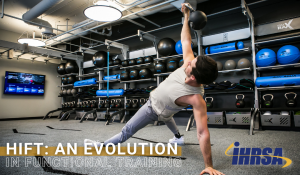CBI Editors recently sourced several industry leaders to gather information for their October feature article ‘Experts Tips for Creating a Winning HIFT Program.’
IHRSA Feature Article – October 2021
High intensity interval training and High Intensity Functional Training are modalities that have been trending for some time – and continue to do so. Club, Studio and fitness amenity operators must accommodate and program for this type of training to remain relevant and facilitate a great exercise experience.
When planning for this, definition and the use of space is the most important focus. This includes considerations such as identifying the ideal area to execute, design and build the space to accommodate the desired programming. Choosing the right fitness accessories and equipment – and their placement, then leads to designing the area so that it’s energetic, fun, and engaging.
Further, HIFT and HIIT programming require ample space for dynamic movement and flexibility so workouts can be changed up daily. Smart gym storage is also essential so that training tools can be accessed quickly by instructors and users.
In short, creating HIFT programming begins with smart gym design.
IHRSA shares key considerations that will help to get you started:
- PRESENTATION & PLACEMENT
The first thing Operators must do is determine where – within the walls of the club, studio or fitness center – the HIFT programming will be executed to generate the best results overall. You may want to consider building out an engaging and energetic training zone within an area where other members can observe (versus a separate room or more private area). This serves to entice more members to potentially get involved, generates great energy, and cultivates a community feel.
Doing this takes thoughtful gym design. You must delineate the space so that members engaged in HIFT training sessions have parameters, while still allocating enough room for dynamic movements. This can be done with gym flooring, floor markings and other creative design elements.
The space must facilitate multiple modalities and – always – safely, so a careful approach to product placement and gym storage is critical.
How will guidance be executed? It’s imperative to design the space for both in-person and digital guidance to get the best usage and ROI from the space.

- PRODUCT CHOICES & USAGE
Designing to facilitate the many fitness equipment and training accessories used in HIFT programming is essential.
Says Andrew Gavigan Director of Education at Aktiv Solutions, “In HIFT, we see a broader utilization of training complements including suspension straps as part of single-use training kits.
He goes on to say, “Additionally, we see resistance bands, wall balls, and stabilization tools. Training walls and suspension bridges are also baseline complements to any HIFT environment.”
Ensuring that all the right tools are at the ready, yet smartly stored so as not to create pinch points or safety hazards, is critical.
- EXPERIENCE & BRANDING
Above all, keep the focus on designing a floorplan to create the best exercise experience and deliver on your brand promise.
Says Gavigan, “Don’t copy, create. This is about delivering quality in both programming and each touch you make with your clients during their time with you. Customers notice the flooring choices, the refinement of the equipment itself, even color choices. Build your brand through results-driven training and program space that people look forward to spending time in.”
To that end, choosing fitness equipment that enhance the space, functionality and aesthetics adds value while differentiating your brand. One great example is FORMA Dumbbells – designed to inspire, built to perform.
“These extra touches add up to differentiate your facility and add ongoing value,” Gavigan says.
For fitness facility design consultation, and more ideas on how you can develop the best exercise experience for your members, contact the Aktiv team.
Read the full article at IHRSA.org.



